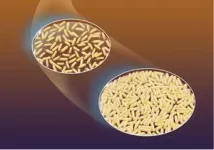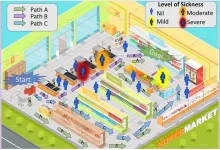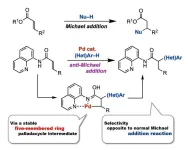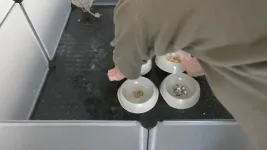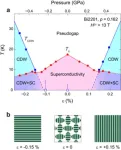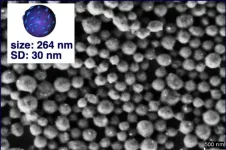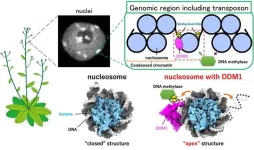Mount Sinai secures over $4 million grant from National Institutes of Health to study alopecia areata and atopic dermatitis in people with Down Syndrome
First-of-its-kind clinical trial with specific JAK inhibition will investigate the best treatment for inflammatory skin conditions in these patients
2024-07-11
(Press-News.org) New York, NY (July 11, 2024) – The Icahn School of Medicine at Mount Sinai is embarking on biomedical research aiming to set new standard-of-care protocols for treating alopecia areata and atopic dermatitis in people with Down syndrome, or trisomy 21.
Emma Guttman-Yassky, MD, PhD, the Waldman Professor and Chair of Dermatology at Icahn Mount Sinai, has been awarded more than $4 million for a five-year National Institutes of Health (NIH) R61/R33 grant to evaluate the long-term safety, efficacy, and mechanisms of medications known as JAK inhibitors in patients with Down syndrome. The medications have been approved by the Food and Drug Administration for treatment of atopic dermatitis and alopecia areata in adults and adolescents generally but have not been studied specifically in people with Down syndrome.
Down syndrome is the most common genetic cause of intellectual disability in the United States, affecting 1 in 700 newborns. In addition to cognitive symptoms, people with Down syndrome frequently experience an increase in inflammatory skin diseases, such as atopic dermatitis and alopecia areata. These individuals also represent a vulnerable population that is seldom included in clinical trials, leaving a void in care protocols aimed specifically at their needs.
“The Down syndrome population has unique medical challenges and considerations that necessitate evaluating the safety and effectiveness of treatments in studies that focus on this specific population,” said Dr. Guttman. “Given how common inflammatory skin diseases are in this population, particularly atopic dermatitis and alopecia areata, we want to ensure that safe and effective treatments are available, and that we understand the effects that they have on immune modulation in people with Down syndrome.”
An R61/R33 NIH grant is a combined mechanism that supports innovative ideas, taking them from the exploratory stage to practical applications with tangible benefits for patients. Ultimately, the goal of these projects is to improve health outcomes and quality of life
This grant will facilitate a multidisciplinary effort of dermatologists, pediatricians, and internal medicine specialists as well as scientists, and intends to identify novel pathways in patients with Down syndrome, while also testing a novel targeted treatment approach. “We are hoping we will be able to better manage skin inflammation in patients with Down syndrome,” said Dr. Guttman.
Dr. Guttman and her team will begin a phase 2 clinical trial to test the long-term dosing regimens of JAK inhibition for a total of 60 weeks of treatment.
The aims of this trial include:
To define the long-term safety profiles of abrocitinib and ritlecitinib in people with Down syndrome who have moderate-to-severe atopic dermatitis affecting more than or equal to 7 percent of the surface area of their body; or Down syndrome patients with alopecia areata affecting more than or equal to 25 percent of their scalp.
To determine the long-term efficacy of abrocitinib and ritlecitinib for 60 weeks in controlling inflammatory skin diseases in adolescents and adults with Down syndrome.
To evaluate Down syndrome-specific molecular mechanisms underlying inflammatory skin diseases and the response to selective JAK inhibition.
###
About the Mount Sinai Health System
Mount Sinai Health System is one of the largest academic medical systems in the New York metro area, with 48,000 employees working across eight hospitals, more than 400 outpatient practices, more than 600 research and clinical labs, a school of nursing, and a leading school of medicine and graduate education. Mount Sinai advances health for all people, everywhere, by taking on the most complex health care challenges of our time—discovering and applying new scientific learning and knowledge; developing safer, more effective treatments; educating the next generation of medical leaders and innovators; and supporting local communities by delivering high-quality care to all who need it.
Through the integration of its hospitals, labs, and schools, Mount Sinai offers comprehensive health care solutions from birth through geriatrics, leveraging innovative approaches such as artificial intelligence and informatics while keeping patients’ medical and emotional needs at the center of all treatment. The Health System includes approximately 9,000 primary and specialty care physicians and 11 free-standing joint-venture centers throughout the five boroughs of New York City, Westchester, Long Island, and Florida. Hospitals within the System are consistently ranked by Newsweek’s® “The World’s Best Smart Hospitals, Best in State Hospitals, World Best Hospitals and Best Specialty Hospitals” and by U.S. News & World Report's® “Best Hospitals” and “Best Children’s Hospitals.” The Mount Sinai Hospital is on the U.S. News & World Report® “Best Hospitals” Honor Roll for 2023-2024.
For more information, visit https://www.mountsinai.org or find Mount Sinai on Facebook, Twitter and YouTube.
END
ELSE PRESS RELEASES FROM THIS DATE:
2024-07-11
How do people like to interact with robots when navigating a crowded environment? And what algorithms should roboticists use to program robots to interact with humans?
These are the questions that a team of mechanical engineers and computer scientists at the University of California San Diego sought to answer in a study presented recently at the ICRA 2024 conference in Japan.
“To our knowledge, this is the first study investigating robots that infer human perception of risk for intelligent decision-making in everyday settings,” said Aamodh Suresh, first author of the study, who earned his Ph.D. in the research group of Professor Sonia Martinez Diaz ...
2024-07-11
Inflation rates may have cooled off recently, but a new poll shows many older adults are experiencing financial stress – especially those who say they’re in fair or poor physical health or mental health.
Women and those age 50 to 64 are more likely than men or people over age 65 to report feeling a lot of stress related to their personal finances. So are people age 50 and older who say they’re in fair or poor physical or mental health.
In all, 47% of people age 50 and older said inflation had impacted them a great deal in the past year, and 52% said they ...
2024-07-11
In 1887, chemist Sir Arthur Michael reported a nucleophilic addition reaction to the β-position of α,β- unsaturated carbonyl compounds. These reactions, named Michael addition reactions, have been extensively studied to date. In contrast, the anti-Michael addition reaction, referring to the nucleophilic addition reaction to the α-position, has been difficult to achieve. This is due to the higher electrophilicity of the β-position compared to the α-position. Previous attempts to overcome these difficulties have involved two main methods. The first is restricting the addition position via intramolecular reactions, ...
2024-07-11
Seagull chicks raised on an “urban” diet still prefer seafood, new research shows.
University of Exeter scientists studied herring gull chicks that had been rescued after falling off roofs in towns across Cornwall, UK.
Raised in captivity (before being released), they were given either a “marine” diet consisting mainly of fish and mussels, or an “urban” diet containing mostly bread and cat food.
Every few days the gull chicks were presented with a choice of all four foods in different bowls, to test which they preferred – and all gulls strongly favoured fish.
“Our results suggest that, even when reared on an ‘urban’ ...
2024-07-11
Superconductors are materials that can conduct electricity with zero resistance when cooled to a certain temperature, called the critical temperature. They have applications in many fields, including power grids, maglev trains, and medical imaging. High-temperature superconductors, which have critical temperatures higher than normal superconductors have significant potential for advancing these technologies. However, the mechanisms behind their superconductivity remain unclear.
Copper oxides or cuprates, a class of high-temperature superconductors, exhibit superconductivity ...
2024-07-11
Scientists have taken a significant step towards the development of tailor-made chiral nanocarriers with controllable release properties. These nanocarriers, inspired by nature's helical molecules like DNA and proteins, hold immense potential for targeted drug delivery and other biomedical applications.
The study, led by Professors Emilio Quiñoá and Félix Freire at the Center for Research in Biological Chemistry and Molecular Materials (CiQUS), highlights the intricate relationship between the structure of helical polymers and their self-assembly into nanospheres. By carefully designing ...
2024-07-11
The grants – each worth €150,000 – help researchers to bridge the gap between the discoveries stemming from their frontier research and the practical application of the findings, including early phases of their commercialisation.
Nanda Rea’s new project, called DeepSpacePULSE, aims to facilitate deep space exploration. Currently, to find their way, spacecraft and satellites use up a lot of energy exchanging vital navigation information with mission coordinators on Earth. Using ERC Proof of Concept funding, Prof. Nanda Rea ...
2024-07-11
Native plants and non-native crops do not fare well in proximity to one another, attracting pests that spread diseases in both directions, according to two new UC Riverside studies.
“We have changed the landscape, and it’s created opportunities for pathogens to thrive,” said UCR entomologist Kerry Mauck, who co-authored the studies. “We have introduced pathogens that damage native plants, and on the other side of the coin we have endemic pathogens that mutate to infect ...
2024-07-11
PULLMAN, Wash. – A small 3-ounce sensor capable of recording 2,400 data points of movement in just one second being tested and refined by researchers at Washington State University could be key in reducing the number of injuries to racehorses.
Led by Dr. Warwick Bayly in WSU’s College of Veterinary Medicine, researchers used the biometric sensors, developed by the company StrideSAFE, to track thoroughbreds as they raced and trained at some of the top racetracks in the country. Using collected data, the team was able to identify miniscule stride changes associated with increased risk ...
2024-07-11
International joint research led by Akihisa Osakabe and Yoshimasa Takizawa of the University of Tokyo has clarified the molecular mechanisms in thale cresses (Arabidopsis thaliana) by which the DDM1 (Decreased in DNA Methylation 1) protein prevents the transcription of “jumping genes.” DDM1 makes “jumping genes” more accessible for transcription-suppressing chemical marks to be deposited. Because a variant of this protein exists in humans, the discovery provides insight into genetic conditions caused by such “jumping gene” mutations. The findings ...
LAST 30 PRESS RELEASES:
[Press-News.org] Mount Sinai secures over $4 million grant from National Institutes of Health to study alopecia areata and atopic dermatitis in people with Down Syndrome
First-of-its-kind clinical trial with specific JAK inhibition will investigate the best treatment for inflammatory skin conditions in these patients


